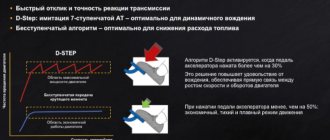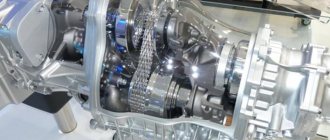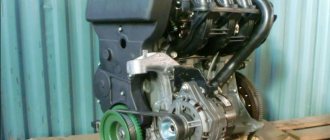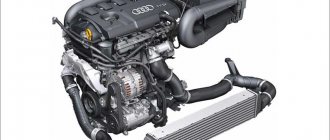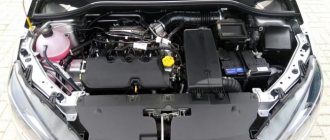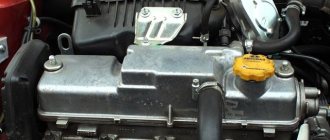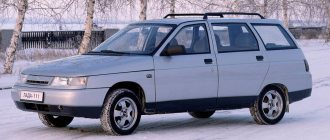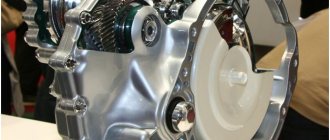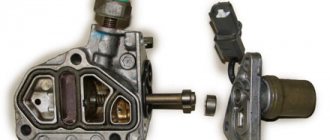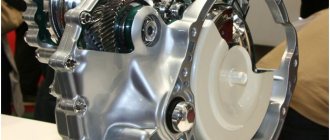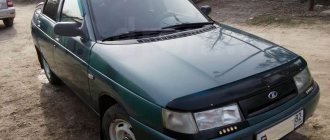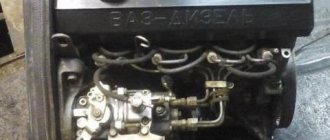What is X-Tronic CVT
The CVT X-Tronic V-belt transmission rolled off the assembly line for the first time in 2010. This was a continuously variable hybrid version of the classic automatic transmission in combination with a 2-speed CVT. Thanks to this design, Jatco was able to reduce the size of the cones and reduce the overall parameters of the transmission.
Early versions of CVT X-Tronic were equipped with cars with 2 and 3.5 liter engines. After modernizing the transmission, it became possible to install it on 1.6 liter models (for example, the new Renault Duster).
When modifying the variator, more than half of the gearbox elements were redesigned:
- pulleys have become more adapted to operation under high loads;
- the belt became aluminum, which had a positive effect on its ductility and service life;
- increased oil pump performance;
- The equipment now includes an Adaptive Shift Control (ASC) system, which allows you to adjust the transmission to the driver’s driving characteristics.
Unlike its predecessors (modification Jatco JF011E), the updated box (model JF015E) has reduced noise pollution (due to low-viscosity oil developed for the variator) and increased the service life of rubbing parts.
The modernization also affected the CVT firmware. Adaptive modes have been added (sports, for difficult roads, etc.). This made it possible to use CVT automatic transmissions in cars with high-power power units.
In 2014, the 8th generation variator was released - JF016E (installed on Renault Arcana), which in terms of hardware is reminiscent of the JF015E, but has some differences. The manufacturer abandoned the step motor (its function was taken over by solenoids-regulators), the operation of the valve body was also adjusted, the power range and the locking zone of the torque converter were expanded.
Do you think the modifications made really improved the performance of the CVT X-Tronic CVT? Write in the comments.
Symptoms of variator failure
Timely replacement of filters and fluid in the box, proper operation, of course, extend the life of the variator. However, breakdowns may still occur. Today, some service stations undertake to carry out both partial and major repairs of this unit, and even provide a guarantee for their work.
Here are a few signs that you should contact them immediately:
- slipping even when you gently press the gas pedal;
- The gearbox goes into emergency mode (an indicator appears on the dashboard);
- vibration;
- jerks or shocks when switching between any gears, both on a warm car and on a cold one;
- gears disappear or do not turn on;
- inhibited reaction to changes in speed;
- extraneous noise;
In reviews of the variator on the Nissan X-Trail, it is often mentioned that such symptoms in many cases can still be corrected without resorting to replacing the entire gearbox.
How does the X-Tronic CVT variator box work?
The continuously variable variator includes the following components and parts:
- pulleys (consist of a pair of metal cones with sharp ends facing each other);
- bracket shafts;
- step motor;
- belt or chain (consists of metal plates);
- bearings;
- hydraulic unit (distribution plate with sensors, filters, solenoids, control valves, hydraulic accumulators);
- oil sump with magnets;
- hydraulic pump (consists of steel blades that move in the grooves of the rotor);
- differential;
- planetary reductor;
- torque converter (for standing start);
- gearbox housing.
Two cone-shaped pulleys (driver, driven), which can move and move apart, are put on the shafts. A V-shaped metal belt is stretched and clamped between them. It consists of pushing segments that cling with teeth to the surface of the cones and create rotational movements.
The differential distributes torque to the driving wheels of the car. The oil sump serves as a support and protection for the working mechanisms and is used to store transmission fluid, without timely replacement of which the CVT box will not last long.
The CVT X-Tronic JF015E gearbox from Jatko is equipped with a planetary gearbox. It consists of gears (satellites), and is designed to reduce transmission and increase torque. Its operation allows you to increase the gear ratio to 7.3*1, which is inaccessible to conventional continuously variable transmissions.
CVT repair stages
Diagnostics
Thanks to professional equipment, a complete examination and diagnosis of the variator is performed. Subsequently, the car owner and a master auto mechanic conduct a test drive of the car to determine all existing faults and defects.
Dismantling and troubleshooting
For high-quality CVT repairs, it is necessary to remove the variator from the vehicle, and then open the gearbox and troubleshoot the transmission.
The variator is removed using a specially equipped lift. These manipulations usually take no more than five hours.
The owner of the vehicle must be present when opening the gearbox and carrying out troubleshooting. This is due to the need to demonstrate to the owner the real condition of his equipment.
Trouble-shooting
After diagnosing and identifying all defects, auto mechanics begin to repair and replace all damaged elements, restoring and repairing the variator.
Assembly and installation of a variator on a Nissan Juke
After restoration work, diagnostics are carried out on computer equipment in order to eliminate the possibility of missed defects.
After computer diagnostics, auto mechanics conduct a test drive. After all checks, the owner of the car is invited to accept the results.
Functionality check
Together with auto mechanics, the car owner makes sure that all repair work is carried out accurately and signs the necessary documents.
The principle and algorithm of operation of the variator
The operating principle of the X-Tronic CVT is not difficult to understand. The machine is driven by the input shaft, which transmits torque from the power unit to the drive pulley (connected to the engine).
The force is then transmitted through the V-belt to the driven pulley connected to the output shaft. The pulleys are able to move apart and move, therefore, depending on their proximity to each other, the gear ratio (vehicle speed) changes.
The transmission of torque is controlled by a step motor. The process also involves:
- differential;
- planetary reductor;
- torque converter.
When accelerating from a standstill, the diameter of the drive pulley is the smallest, the discs are compressed. As the speed increases, the distance between them increases, and at maximum acceleration it becomes the largest. It follows that the conditional number of available speeds for CVT is large.
The operating principle of the variator box provides the car with excellent acceleration dynamics and smooth movement without interrupting the power flow. Also, when driving in the car, there are no jerks, dips, or jolts characteristic of automatic and manual transmissions.
What system is used to implement the CVT X-Tronic operating algorithm?
The CVT X-Tronic operating algorithm is implemented using the PRND system, as in torque converter transmissions. The abbreviation stands for the following provisions: • P – parking; • R—reverse; • N—neutral speed; • D – main working position.
The software part of the variator processes the information and changes the operating mode of the gearbox. The driver only needs to select the driving mode.
Tips for use
Due to its design features, the X-Tronic CVT variator has operating nuances. To maximize the life of the unit, you must follow the following rules:
- Maintain cleanliness and the required level of transmission fluid in the pan (how much oil and when to change is indicated in the instructions for the gearbox). Dirty lubricant accelerates gearbox wear.
- Before driving, warm up the variator and do not load it at temperatures below +60 °C at a speed above average. Cold oil causes the belt to slip on the cones and the friction clutches on the pulleys.
- Take care of the CVT. Increased load on the variator leads to overheating, which accelerates the aging of consumables several times.
- Do not accelerate the car above the speed limit. This reduces the lifespan of bearings and other gearbox elements.
- If you notice a whistling, knocking or noise in the gearbox, contact a service station to diagnose the problem, repair and replace the transmission fluid.
You can diagnose and fix problems of any complexity at the CVT Repair Center No. 1. Get additional information by calling: Moscow – 8 (495) 161-49-01, St. Petersburg – 8 (812) 223-49-01. We accept calls from any region.
Service life of the Nissan Zhuk variator
The service life of this variator depends directly on compliance with operating rules and on the terrain on which the gearbox is used. The manufacturer assures that the operating reserve reaches 200 thousand km. Upon reaching this indicator, the device requires major repairs.
It is worth noting that in the case of towing trailers and other cars, as well as using untested filters, oils and possible overheating of the device due to high temperatures, there is a risk of reducing the service life of the Nissan Zhuk CVT by half.
Resource and reliability of the X-Tronic CVT box
The CVT, like a continuously variable transmission, helps the engine operate at optimal speeds, which allows the car to get good dynamics and save fuel. But many car enthusiasts do not trust the CVT X-Tronic.
The CVT transmission has a number of limitations that engineers have still not been able to overcome. For design reasons, the belt is not capable of transmitting the high torque generated by the engine.
The peculiarity of the operation of such a gearbox is the constant friction of the clutches against each other. This produces metal shavings, which quickly spread throughout the parts of the gearbox, damaging the components. Therefore, the variator periodically requires a complete oil change. Its production resource depends on the mileage, and on average is 40 thousand km (in unfavorable conditions 30-35 thousand).
If you undergo diagnostics and change oil and filters in a timely manner, the X-Tronic variator will last a long time. Otherwise, the gearbox will quickly become unusable and require replacement (CTV repair is specific and does not fully restore the original performance characteristics).
Do you believe in the reliability of the CVT X-Tronic?
Yes of course!
27.59%
No
72.41%
Voted: 29
We invite you to watch a video review of the most reliable CVTs.
Oil service
It is worth thinking about carrying out repairs and changing the oil in the Nissan Zhuk variator when the mileage reaches approximately 50-60 thousand km. Proper oil change involves replacing not only the fluid itself, but also repairing it with a replacement filter along with it.
The oil must be changed in order to extend the service life of the valve body and solenoids as long as possible, and to protect it from repairs.
Replacing filters is necessary to ensure that working oil is constantly cleaned from used oil.
The correct choice of oil should be based on the transmission model, so that its repair does not become a constant reason for visiting a car service center.
In theory, you can repair and change the oil in the variator yourself, but in order to avoid emergency situations, it is best to contact qualified specialists from our service center.
Cons and possible malfunctions
Typical problems with the X-Tronic CVT:
belt failure, sliding on the cone surface. Leads to wear of the notches and eaten segment protectors;
depletion of bearing life. Untimely replacement can lead to gearbox failure;
wear of the oil pump pressure reducing valve. Leads to insufficient oil pressure in the gearbox;
failure of the step motor is dangerous due to the cones hanging in one position. In this case, the computer will not be able to change the gear ratio of the variator.
The exhaustion of the life of the heat exchanger, oil and filters also requires timely replacement. If you delay the procedure, the continuously variable transmission will not last long.
Despite minor problems, X-Tronic CVTs are popular. And if problems suddenly arise, specialists from the CVT Repair Center No. 1 will help you deal with them. You can get additional free consultation by calling: Moscow – 8 (495) 161-49-01, St. Petersburg – 8 (812) 223-49-01. We accept calls from all regions of the country.
CVTs for Nissan Qashqai (what are the models, modifications and their differences)
The CVT on the Qashqai is often discussed on the Internet (they talk about reliability, oil changes, etc.) without even suspecting that 4(!) different models
CVTs from Jatco. But a simple automatic transmission was also installed on the Qashqai. ))) To avoid confusion, we decided to prepare an article about this. Separately, we will also talk about the first and second (!) generations of Nissan Qashqai, depending on the sales market.
First(!) generation « Nissan Qashqai
"(
J10
) were produced in Japan and the UK from 12.2006 to 2013 and sold in different countries, not only under the name "Nissan Qashqai", but also "
Nissan Dualis
" (in Japan) and "
Nissan Rogue
" in the USA. By the way, right-hand drive Nissan Dualis and left-hand drive Nissan Rogue are quite common in the Russian Federation (quite a lot of them were imported used from Japan and the USA). The first generation Nissan Qashqai was equipped with 2(!) CVT models and 1 automatic transmission model:
a) CVT Jatco JF011e
, aka
RE0F10A
(with a 2.0 liter petrol engine) b) CVT Jatco
JF015e
, aka
RE0F11A
(with a 1.6 liter petrol engine) c) Jatco
JF613E
together (with a 2.0 liter diesel engine).
This information is presented in more detail in the table below:
Important points:
1. Nissan Qashqai with diesel
(!) engine and automatic transmission were not officially sold in the Russian Federation.
Accordingly, there are few such cars on the secondary market in the Russian Federation, but there are quite a lot of them in the countries of the former USSR and in Europe. Nevertheless, the Jatco JF613E
is quite reliable (250,000 km is not the limit), and its repair is inexpensive - spare parts are available. This automatic transmission model was installed, among others, on Renault Megane, Laguna, Mitsubishi Outlanders, Nissan Pathfinders, etc. If you have the opportunity to buy a diesel Nissan Qashqai with this simple automatic transmission on the secondary market, this is a good choice!
2. Gasoline engine 1.6
(together with the
JF015e
) began to be installed on front-wheel drive Nissan Qashqai after the restyling of the model,
in November 2011
.
Such cars are not so common on the secondary market (compared to a 2.0-liter gasoline engine). Unfortunately, the resource of the JF015e
on Qashqai is one and a half to two times less than that of the JF011e variator (Qashqai turned out to be too heavy for the small JF015e variator). If you are buying a used first-generation Nissan Qashqai (2007-2013), then it is better to choose one with a 2-liter engine, due to the more reliable CVT model with this engine. If you come across a good and inexpensive Nissan Qashqai with a 1.6 engine, then pay attention to the service book and work orders for this car. If the previous owner changed the oil in the variator every 40,000 - 50,000 km (including removing the pan and cleaning the magnets from chips), then there is a chance that the variator will last a long time.
3. CVT model Jatco JF011e
(aka
RE0F10A
according to Nissan classification) is the most popular CVT on the first generation Nissan Qashqai (more than 90% of such cars are on the secondary market in the Russian Federation).
By the way, this is the most reliable(!) CVT (of all other CVT models that were installed on Qashqai of the first and second generations). And its repair is the most inexpensive (since there are a large number of spare parts for it). By the way. In the JF011e variator you can safely pour transmission oil of the NS-2
(original or analogue), and in the JF015e variator - only
NS-3
. For more information about changing the oil in JF011e variators (with catalog numbers of non-original consumables), we have a separate article here.
4. In addition to the CVT model, there is such a thing as modification
(!) variator.
These modifications are quite often not interchangeable with each other
(which must be remembered if for some reason you decide to buy a used variator instead of repairing it).
This will save you time and money. Different modifications of CVTs also differ in different hydraulic units (figuratively speaking, “ the brains of the CVT
”). If your valve body fails, then you need to buy exactly the one you had (the valve block numbers are above in the table). If you buy a more modern valve body (even if it’s also from Qashqai), then there is a high probability that your car will not work, since a different version of the valve body may simply be incompatible with the control unit. It happens.
5. On Nissan Qashqai+2
(extended Qashqai) a variator of the same model (Jatco JF011e) was installed as on a simple Nissan Qashqai, but
with different(!) modifications
.
In fact, the same modifications of the JF011e variator were installed on the Nissan Qashqai+2 as on the Nissan X-trail
.
Thus, the Qashqai CVTs on the Qashqai+2 are not completely interchangeable
(you cannot put one in place of the other). On the other hand, since the modifications of the variator on the Nissan Qashqai+2 are different, the service life of the variators on the elongated Qashqai is longer (in these modifications even the metal variator belt is used from 12 belts, and not from 10, more about the metal belts on this variator we have a separate article here.). Thus, if you are choosing on the secondary market between a simple Nissan Qashqai and a Nissan Qashqai +2, then the extended Qashqai is more preferable due to the more powerful modification of the variator that was installed on it.
6. Nissan Qashqai in the USA
called “
Nissan Rogue
” it was equipped with a more powerful 2.5 petrol engine (QR25DE) than the Nissan Qashqai for Europe. This is one of the reasons why Nissan Rogue from America is in demand in the Russian secondary market. In essence, you get the same Qashqai, but Japanese(!) and not English-assembled and with a more powerful engine. Not a bad alternative. Also, more powerful modifications of the JF011e CVTs (with a reinforced metal belt) were installed on the Nissan Rogue. Read more about the Nissan Rogue later in this article.
Right-hand drive Nissan Qashqai
The first generation from Japan (called
Nissan Dualis
) also have a Japanese assembly (and more powerful modifications of CVTs) and they are not so rare in the Russian Federation.
If you don't mind right-hand drive
, then
the Nissan Dualis is a good choice!
By the way, Nissan Dualis was produced in Japan right up to March 31, 2014. That is, many copies are quite fresh.
7. If you already own a Nissan Qashqai (first generation) and your variator behaves strangely (not as usual), then do not leave it for later, in the hope that maybe it will pass. At an early stage of a problem, the cost of solving it is significantly lower than if the problem is started. This is the same as in dentistry - curing a tooth (with early caries) is faster and cheaper than curing pulpitis of the same tooth six months later. However, in the Russian Federation, according to statistics, most people go to the dentist precisely when the tooth is already sick. Don't do this with a CVT - it will save you good money. To make sure that there is something wrong with the variator (and make a decision on repair) - you can measure the pressure in the variator yourself (there is an article on how to do this correctly yourself here! There is no way to measure the pressure yourself - go to a service center where they will do one for you CVT diagnostics For example, in our specialized CVT repair service (in Moscow and St. Petersburg) such diagnostics are generally free.
8. If you are just planning to buy a Nissan Qashqai car
(first generation) and are considering buying a specific car (with a low price) with existing CVT problems - then this is a good option to save on your purchase.
The work of overhauling the variator (JF011e and JF015e) costs only 10,000 rubles (without removing/installing the variator on the car) or 17,000 rubles (with removal/installation). Plus the spare parts that need to be changed in it (what exactly is damaged can only be seen when the variator is damaged; no one can tell before). However, when repairing a variator, you can install modernized
(reinforced) spare parts into it (for example, the same reinforced
oil pump pressure reducing valve
). As a result of this, you will receive a repaired variator with new spare parts inside, which will not give you headaches for several years, even with your active driving and high mileage (the life of the JF011e variator is more than 400,000 km, if you regularly change the oil in it, here is an example video
—————————————————————————————————
Second generation Nissan Qashqai
(
J11
). Produced since the end of 2013. It is currently produced in four factories - in the UK, Japan, China and Russia (in the Russian Federation since 10.2015). Officially, until 10.2015, English-assembled cars were sold on the Russian market, and then only local Russian-assembled ones. Only Japanese assembly was supplied to the USA.
Let's talk about the official market of the Russian Federation and Eastern European countries. Until 10.2015, English-assembled Nissan Qashqai were supplied to the Russian Federation (from 10.2015 - only Russian). In other countries of Eastern Europe, English-assembled Nissan Qashqai continues to be sold. We have compiled a detailed table that shows which models and modifications of CVTs (valve units and torque converters) were installed on the Nissan Qashqai in the J11 body:
Important points:
1. If you buy a new(!) Nissan Qashqai
second generation, then in fact you can buy it with any model(!) CVT (all of them have a warranty period of 100,000 km - this is not a problem).
The problem (alas) will begin after the warranty period. If you initially plan to drive this car for a long time (more than 200,000 km), then the most justified purchase will be a front-wheel drive (!) Nissan Qashqai
with a 2-liter gasoline engine and a Jatco JF016e CVT (variator modification
31020-3VX2A
).
And then , subject to mandatory oil changes
(with cleaning of the pan) in this variator at least once every 40,000 km (more on this below).
Why 2WD and not 4WD? Because one of the weak points of the modification of the variator 31020-3VX2
C (4WD) is the differential, which often breaks the seat in the variator body - and for this reason the variator has to be removed and completely repaired (repair the body). There is no such problem with the front-wheel drive version of the Qashqai.
2. If you want to buy a used(!) Nissan Qashqai on the secondary market
and you are considering both the first and second generations of the model (this is not important for you), then in terms of the reliability of the variator, the most justified purchase of the first (!) generation Nissan Qashqai, after restyling (preferably 2012-2013) with an engine
Jatco JF011e
variator . It is much more reliable (it has a longer service life) than the JF015e, JF016e and JF017e CVTs.
3. If you specifically want to buy a used(!) second generation Nissan Qashqai
, then the most justified purchase would be with a 1.2 engine and a
Jatco JF015e
. The reasons are simple:
a) according to statistics, Nissan Qashqai with a 1.2 engine (as opposed to 2.0) was often bought as a second car for a family (wife, daughter, etc.) with the goal of “ getting to the store and picking up the child from school”
". That is, they have lower mileage and are, as a rule, in better condition than Qashqais with a 2.0 engine (including with regard to the “residual life” of the variator).
b) the fact is that you do not know how the previous owner of the Qashqai used the car and the CVT before you. Let’s assume the worst, that he “ drove both tail and mane
"and the variator has already exhausted its service life by 70-80% (which means there is a possibility that six months or a year after purchasing this Qashqai you will be faced with the problem of repairing the variator, and at your own expense).
So, in the secondary market, the second generation Nissan Qashqai (with 1.2 and Jatco JF015e CVT) not only costs less initially, but also a possible (upcoming) repair of the Jatco JF015e CVT will cost you 30-40 % cheaper
than repair of the Jatco JF016e CVT /JF017e. And if after repairing the Jatco JF015e you use it carefully (and change its oil), then the Nissan Qashqai will serve you for a long time.
4. Due to design features, Jatco JF016e / JF017e
—
very critical
of the cleanliness of transmission oil.
Previous CVTs (Jatco JF011e on the first generation Qashqai) had a so-called “step motor” that “ changed gears
”.
If it became clogged with chips or other wear products, it was often enough to remove it and wash it, and it was inexpensive. In the Jatco JF016e / JF017e
, the step motor was abandoned, and the gears are already switched by so-called “
regulator solenoids
”.
They (in turn) easily and quickly become clogged with dirt and in the worst cases, you have to replace the entire valve body
assembly with a new one(!). And a new hydraulic unit (31705-28X0B, 31705-29X0D) costs about 45,000 rubles ($700). How often should the oil in the variator of this model be changed? Ideally, at least once every 40,000 km. If you can’t afford it for economic reasons, change it at least once every 60,000 km.
5. The Jatco JF016e and JF017e CVTs do not have a “calibration value module” (which, in turn, is present in the Jatco JF011e and Jatco JF015e models). What does it mean? Imagine that your variator is broken, after repair you install the variator back on the car and the valve body (previously) itself automatically took the calibration values it needed from the so-called “tablet”. And now it’s gone, and the calibration values are filled in once (!) once at the manufacturer’s factory during the production of the machine. They are taken from a unique(!) CD that comes with each valve body (but this CD is not given to the car owner when purchasing a new car) Why is this bad?
a) it is useless to buy a used (contract) variator (JF016e and JF017e). It “will not work” because there is no CD for the valve body, which is installed in the pan of this contract variator. And when removing this variator from a “damaged car,” no one naturally thought that this data should be downloaded at least onto a flash drive (and few people have special equipment for this). That is, the market for contract CVTs of the Jatco JF016e and JF017e models has actually “disappeared”. And those that are sold on the Internet are actually only suitable for spare parts.
b) you can’t repair the Jatco JF016e and JF017e variator in any “garage” service. Previous models of CVTs (Jatco JF011e and Jatco JF015e), some people (especially in the regions) even managed to remove, repair (replace damaged parts) and put them back in the “pit”. You will go to any lengths to save money. That's it, those times are already gone. Few people have special equipment for reading/writing calibration values.
Nissan Qashqai for the US market.
This chapter is of interest to those who live in the USA / Canada or those who are planning to buy an " American Qashqai"
"(both new and used). The first(!) generation Nissan Qashqai for the US market was produced at the Japanese and Taiwanese Nissan factories and had (which is important) two names depending on the date of sale (marketing):
a) Nissan Rogue
(2007-2013) b)
Nissan Rogue Select
(2014-2015)
These cars were equipped with a gasoline engine with a volume of 2,5
liter (
QR25DE
) and a Jatco
JF011e
(
RE0F10A
).
But since the American market was very important for Nissan, many different (!) modifications of this variator were installed on the Nissan Rogue
, including reinforced ones intended for transporting trailers, and there was a separate modification of the variator for the state of California (there are different environmental standards, the hydraulic unit was changed accordingly to comply with these standards). Table below:
If you plan to buy a Nissan Rogue from the USA on the secondary market, then it is better to choose a modification with a reinforced variator (designed for transporting trailers) - 310C0-1XF7A or 310C0-1XF6E. On the used spare parts market in the Russian Federation, sometimes there are offers for the sale of CVTs (for the same Qashqai) from Japan and the USA. However, as you can see, the modifications of the CVTs are different(!) and these CVTs cannot be installed on the European Qashqai without major modifications. The same “variator bell” (“docking” to the engine) on the American Qashqai is made for the QR25DE engine. But the European Qashqai has a different engine and, accordingly, a different bell (they are not interchangeable).
Second generation Nissan Qashqai for the US market
also has its differences.
Firstly, since 2014, under the name “Nissan Rogue” in the USA, they began to sell the familiar “Nissan X-trail” of the latest generation (it is for this reason that the first generation Qashqai was sold in the USA under the name “Nissan Rogue Select” during 2014-2015 ). Secondly, since the name “Nissan Rogue” was already taken (under the X-trail), the second generation Nissan Qashqai began to be sold in the USA only in January 2022 under the name “Nissan Rogue Sport”
. The cars were assembled at the Japanese Nissan plant and delivered (supplied at this point) to the USA. The main difference (from the European and Russian versions we are used to) is the front and rear optics.
Nissan Rogue Sport CVT modifications:
Conclusion.
The Nissan Qashqai (regardless of the generation, right-hand drive or for the US market) is a fairly reliable car. Don't be afraid of CVTs on Qashqai. Frequent PARTIAL oil changes in the variator (at least once every 40,000 km) with the obligatory(!) removal of the sump and cleaning the magnets inside the sump from chips - significantly extends the life of the variator (regardless of the variator model). Moreover, this procedure is inexpensive (the price is only 2500 - 3000 rubles for the work). At the first(!) symptoms of problems with the variator (if the problem is not delayed), there is a high probability of getting away with a “little loss of life”. Just call and come for diagnostics (without putting it off until tomorrow).
Best regards, Jatco
Are you having any problems with your CVT? Then it’s better to call immediately and come for diagnostics (we are in Moscow and St. Petersburg). Our phone number in Moscow
—
8 (499) 110 12 41
Our phone number in
St. Petersburg
—
8 (812) 334 18 49
